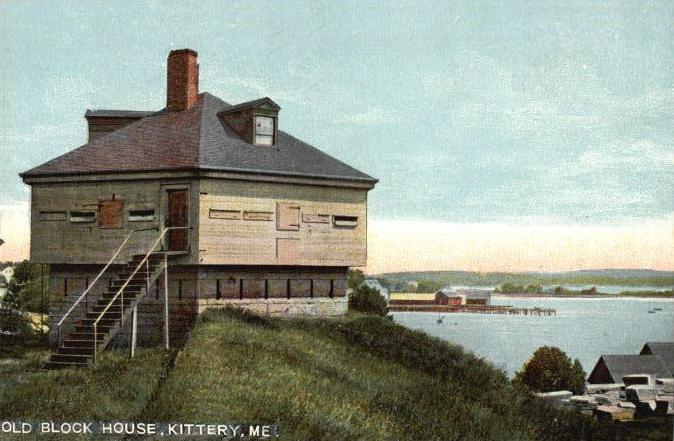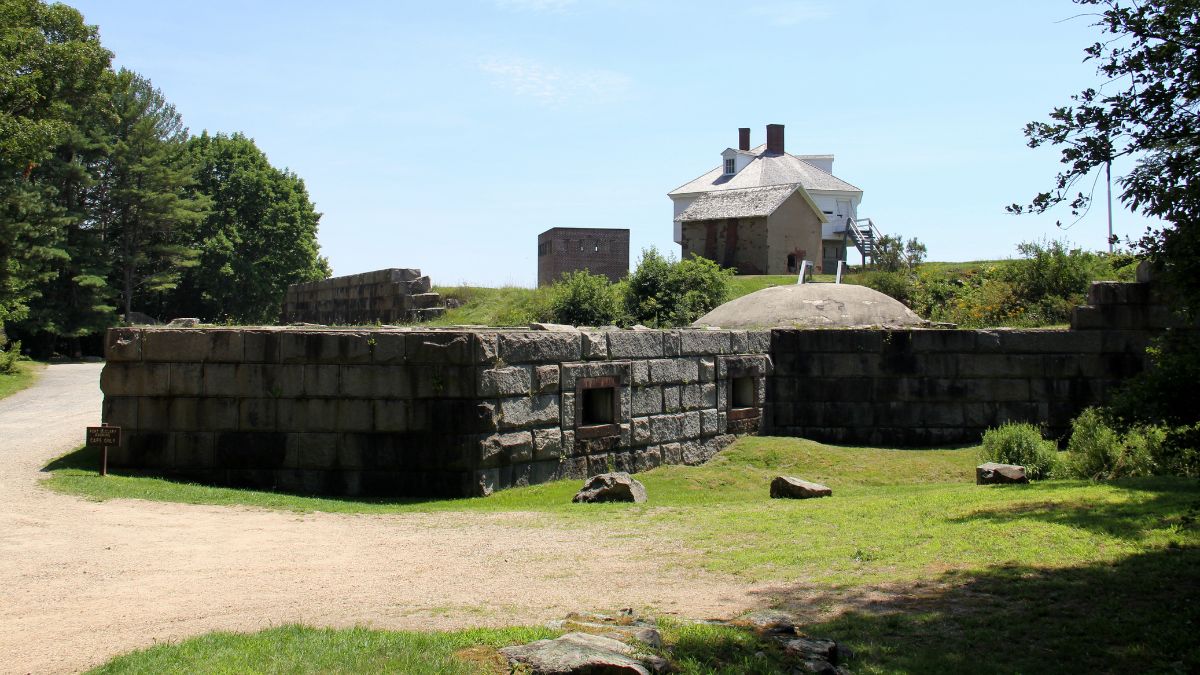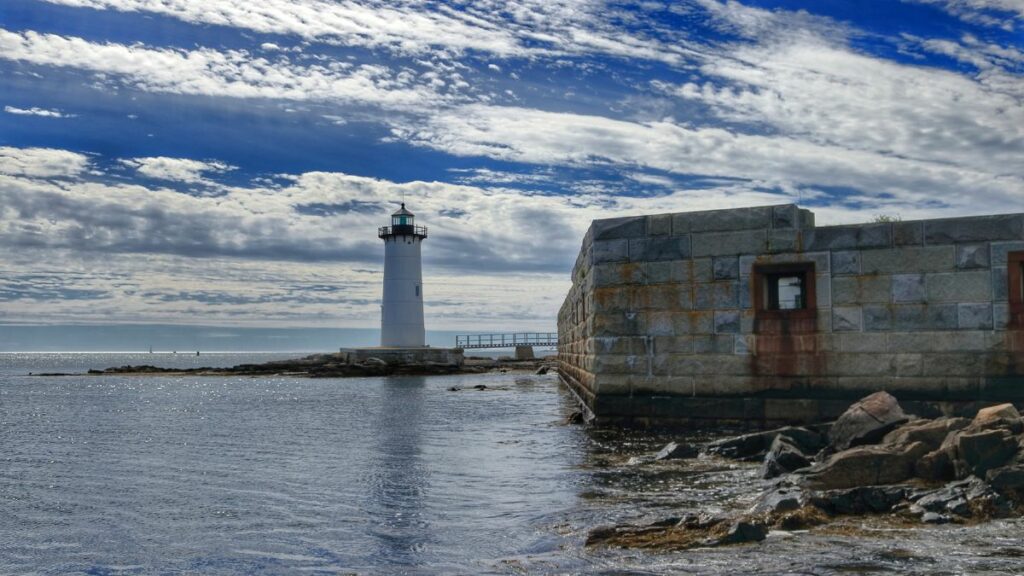Nestled along the Piscataqua River, Kittery, Maine, boasts a rich military history, evident through its numerous well-preserved forts. Fort McClary State Historic Site is among the most notable, an essential fortification during the Revolutionary War, Civil War, and Spanish-American War.
Its connection to New Hampshire native Major Andrew McClary, who fought in the Revolutionary War’s Battle of Bunker Hill, further solidifies its historical significance.
Visitors to Fort McClary State Park can explore its military architecture, including the impressive hexagonal blockhouse, granite powder magazine, and the remnants of Battery Bohlen and Battery Chapin.
The park also offers picnic areas, designated trails, and spectacular views of Portsmouth Harbor Light and the surrounding area. This site is a treasure trove for history buffs and provides a friendly place to unwind and appreciate the region’s beauty.
Kittery Point area is also home to other Maine forts, such as Fort Foster Park, Fort Knox, and Fort Constitution, further illustrating the area’s defensive needs throughout various wars.
With multiple parks offering a peek into the past, Kittery is truly a gateway to the rich military history of Maine and the United States.
History of Forts in Kittery Maine

Revolutionary War
Forts have played a vital role in the history of Kittery, Maine. Located on the Piscataqua River, the town of Kittery served as the southern gateway to Maine. The Revolutionary War’s Battle of Bunker Hill was instrumental in establishing forts in the area, such as Fort McClary.
New Hampshire native Major Andrew McClary, who was killed in this very battle, has a state historic site named after him – the Fort McClary State Historic Site.
The site consists of several buildings and structures from different construction periods, showcasing the military architecture of the time. Among them are the hexagonal blockhouse, the granite powder magazine, the cut granite wall, the caponier, and the rifleman’s house.
War of 1812
During the War of 1812, Kittery’s forts were fortified to protect the surrounding area and the Isles of Shoals. Fort William and Fort Constitution were significant forts defending the region during this period. The state of Maine recognized the importance of these forts and took necessary measures to meet the area’s defensive needs.
Civil War
The Civil War brought further development to the forts in Kittery. Fort Knox’s granite walls and extensive underground tunnel systems exemplify this era’s military architecture. The fort played a crucial role in defending the nearby tidal waters of Barters Creek and Chauncey Creek.
World War I
By World War I, like many forts in Maine, those in Kittery experienced modernization and expansion. The introduction of concrete fortifications, such as Battery Bohlen and Battery Chapin, which were part of Fort Foster Park, helped adapt to the changing strategies of warfare.
In addition to their defensive purpose, these sites provided evidence of military history and offered spectacular views of Portsmouth Harbor Light.
World War II
The involvement of the United States in World War II entailed further modifications and advancements to Kittery’s forts. A combination of new constructions and adaptations to the existing fortifications, such as transforming the mess hall into a temporary barracks, marked the area’s contribution to the ongoing war efforts.
Visiting these forts today, it is easy to appreciate Kittery’s coastal defenses’ rich history and strategic importance. Fort McClary State Park offers designated trails, picnic areas, and limited parking for history buffs and casual visitors.
The park is open daily from Memorial Day to Columbus Day, with an off-season pass also available for sale. The Friends of Fort McClary offer guided tours and events that focus on the history and significance of these remarkable structures. To plan a visit, take US Route 1 or the Maine Turnpike and follow the directions to Kittery Point, where you will find a larger rotary and a friendly place to explore the fascinating past of Kittery’s historic forts.
Related: Historic Forts in Maine: Fascinating Sites You Can Visit
Historic Forts of Kittery, Maine
Kittery, Maine, located near the Piscataqua River, is home to several historically significant forts. These forts played important roles during the American Civil War, Spanish-American War, and World War I. The major forts in the town of Kittery include Fort McClary, Fort Foster Park, Fort Stark, and Fort Dearborn. This article will briefly cover each fort and its significance in history.
Fort McClary

Fort McClary, situated at the southern gateway to the Piscataqua River, is named after New Hampshire native Major Andrew McClary, who fought in the Revolutionary War’s Battle of Bunker Hill. Fort McClary State Historic Site is a great place for history buffs to explore.
The fort showcases different construction periods, with evidence of military architecture from the Revolutionary War to World War I.
Some highlights of Fort McClary State Park include the hexagonal blockhouse, cut granite first-story walls, and the granite powder magazine. The park offers spectacular views of Portsmouth Harbor Light and the surrounding area, and during the off-season, visitors can still access the fort via a small parking lot. The Friends of Fort McClary group assists in preserving and promoting the fort’s history.
Fort Foster Park

Fort Foster Park, located on the southwest tip of Gerrish Island, was mainly active during the Spanish-American War and World War I. The fort features Battery Bohlen and Battery Chapin, which saw little conflict but were crucial in the area’s defensive needs. The park offers designated trails, picnic areas, and limited parking, making it a friendly place for a day visit.
An interesting site within the park is the rifleman’s house, which dates back to the 1800s. Besides the military history, Fort Foster Park boasts beautiful views of the Isles of Shoals, Barters Creek, and Chauncey Creek tidal waters.
Fort Dearborn
Part of Fort Foster Park, Fort Dearborn, has a rich history dating back to the 1800s. The fort’s remnants, such as the caponier and second story features, offer visitors a glimpse into the past. Although the fort’s military history is limited, the site remains important as one of Maine’s significant historic forts.
To visit the forts in Kittery, take exit 2 off the Maine Turnpike (I-95) onto US Route 1. Remember that the area fills up quickly during peak times, such as Memorial Day and Labor Day weekends. Consider purchasing a season pass for easy access to the major parts of the forts in the Kittery Point area throughout the year.
Noteworthy Features and Attractions
Lighthouses and Harbor Views

Kittery, Maine, offers spectacular views of Portsmouth Harbor Light and Isles of Shoals. The Portsmouth Harbor Lighthouse, located at the southern gateway of the Piscataqua River, is a must-see attraction for visitors. The Whaleback Lighthouse, situated on a rocky island at the entrance to the harbor, is another iconic beacon visible from Kittery Point.
Walking and Hiking Trails
Fort McClary State Park and Fort Foster Park offer designated walking and hiking trails for visitors to explore the area’s natural beauty. Trails wind around the picturesque Chauncey Creek and Gerrish Island, showcasing breathtaking views of the surrounding area and the tidal waters of Barters Creek. Hiking trails are suitable for all ages and offer a friendly place for outdoor enthusiasts to enjoy the town of Kittery.
Picnic Areas and Beaches
Kittery’s parks boast picnic areas with tables for visitors to enjoy meals with scenic views. Fort McClary State Park and Fort Foster Park have limited parking but offer sandy beaches and rocky shores, perfect for picnicking, swimming, kayaking, and fishing. During the off-season, from Labor Day to Memorial Day, some picnic areas may not be accessible due to restricted access or parking limitations.
Museums and Military History
The area’s military architecture is showcased in several historic sites, including Fort McClary State Historic Site and Fort Foster Park. Fort McClary was an active military post during the Revolutionary War, Civil War, and Spanish-American War.
The hexagonal blockhouse, rifleman’s house, and the granite powder magazine are significant structures, displaying different construction periods and military history. The Friends of Fort McClary organization regularly hosts events and provides information about the fort’s fascinating history.
Fort Constitution, located in New Hampshire, Native Major Andrew McClary’s hometown, is another important historic site. It played a key role in the Revolutionary War’s Battle of Bunker Hill. Visitors can view the remains of Battery Bohlen, Battery Chapin, and the earthworks constructed during World War I.
The Kittery Point area also offers a glimpse into the area’s defensive needs during the Civil War and other significant wars. With state parks and historic forts, history buffs can learn much about Maine’s military past while enjoying the region’s natural beauty.
Visiting Forts in Kittery Maine
Kittery, Maine, is home to several historic forts that played significant roles during military history, including the Revolutionary War, Civil War, and World War II. Fort McClary State Historic Site and Fort Foster Park are prominent forts in the area.
Accessibility and Parking
Most Maine forts, including Fort McClary State Park and Fort Foster Park, are easily accessible by car. To reach Fort McClary, take US Route 1 and exit at Kittery Point. Limited parking is available at a small parking lot near the entrance. For Fort Foster Park, take the Maine Turnpike, and follow the signs to the park after passing through the town of Kittery. Parking fees apply, although a season pass can be purchased.
| Fort | Parking Fee |
| Fort McClary State Historic Site | May vary, check the official website |
| Fort Foster | $10 for residents; $20 for non-residents |
Pet Policies
Dogs are generally permitted at Maine forts, but owners must abide by park rules. In Fort McClary State Park and Fort Foster Park, dogs must be leashed at all times and cleaned up after. Always check the specific regulations for each fort before visiting.
Park Rules and Regulations
To preserve the rich military history and natural beauty of the parks, visitors are required to follow park rules and regulations:
- Stay on designated trails and do not enter restricted areas
- Respect the historic structures and artifacts
- No climbing on walls, structures, or trees
- Observe proper etiquette for picnic areas
- Follow all posted rules and guidelines
Visitors can explore the granite structures, such as the hexagonal blockhouse and granite powder magazine at Fort McClary, or the remains of coastal defense structures like Battery Bohlen at Fort Foster Park. Both parks offer spectacular views of Portsmouth Harbor, the Piscataqua River, and the surrounding area.
In addition to their military history, many of the Maine forts are ideal for recreational activities. Picnic areas are available at both Fort McClary and Fort Foster, providing an excellent spot to take in the stunning views over the tidal waters of Barters Creek, Chauncey Creek, and Pepperrell Cove.
Related: Historic Forts in Portland Maine: A Complete Guided Tour
Conclusion – Forts in Kittery Maine
These forts are essential to the region’s cultural heritage, serving as important landmarks during significant wars such as the Revolutionary War and the Battle of Bunker Hill. By visiting these forts, history buffs can immerse themselves in the past while enjoying the natural beauty of the surrounding landscape.
Have you visited any of these forts in Kittery, Maine? If you have, please let us know in the comments below.

Cory is a website owner and content creator who enjoys fishing, history, coin collecting, and sports, among other hobbies. He is a husband and father of four.
Romans 15:4 For whatever was written in former days was written for our instruction, that through endurance and through the encouragement of the Scriptures we might have hope.

